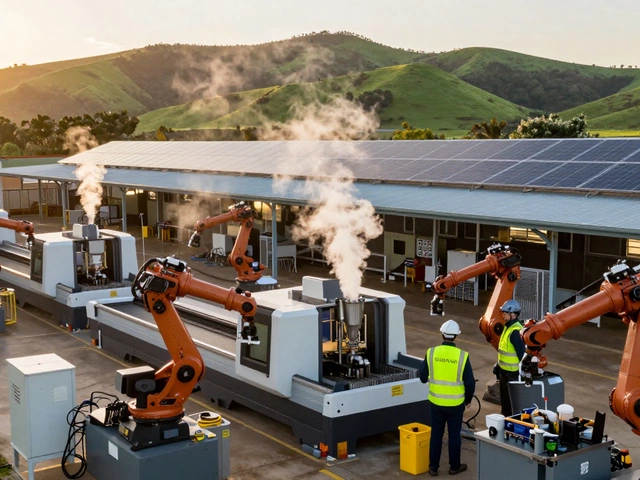Why Ford Exited India: A Closer Look at its Decision

On September 9, 2021, Ford Motor Company announced its withdrawal from the Indian market, ending its 25-year stint in the country. This decision sent ripples through the automobile sector, leaving many to wonder why a global giant like Ford would retreat from a rapidly developing automotive market.
It's a tale with many layers, involving intense competition, persistent financial struggles, and strategic realignments. Over the years, the Indian automobile landscape grew incredibly competitive, with numerous domestic and international players offering a wide range of products. Unfortunately for Ford, maintaining a strong footfall amidst this competitive storm proved difficult.
At the heart of Ford's departure was a sustained lack of profitability despite considerable investments. The company encountered challenges in capturing the market share necessary to justify its ongoing operations. Changes in customer preferences, regulatory landscapes, and sudden economic shifts only added to the complexity.
This article will explore the intricate dynamics that led to Ford's decision, examining the historical context and the broader impact on the industry and its stakeholders. We aim to provide you with insights into the reality of global automotive operations in a region bustling with potential yet fraught with challenges.
- Background of Ford in India
- Challenges and Competition
- Impact on Stakeholders
- Future of Auto Manufacturing in India
Background of Ford in India
The story of Ford India is a tale of ambition, hurdles, and a quest for sustainability in one of the most competitive automobile markets. Ford entered the Indian market in 1995, establishing a 50-50 joint venture with Mahindra & Mahindra, a leading player in the sector. The aim was clear: capitalize on India's burgeoning economy and the growing middle class desiring personal mobility. By 2019, Ford had invested over $2 billion and established two state-of-the-art manufacturing facilities in Chennai and Sanand, hoping to cater not just to the local market but also leverage India as an export hub.
The initial years were marked by modest success. Cars like the Ford Ikon and Ford Fiesta resonated with the consumers, who appreciated their robust build and superior driving dynamics. However, Ford faced several challenges, including the high cost of production and the necessity of scaling quickly to compete effectively with local players like Maruti Suzuki and Tata Motors, who enjoyed a stronghold due to competitive pricing and a deeper understanding of consumer needs.
A significant turning point came with the launch of the Ford EcoSport in 2013, which was well-received and became a bestseller in the compact SUV segment. But success stories like these were sporadic. Persistent challenges around high import and operational costs, coupled with a lack of new, affordable models tailored for the Indian market, began impacting Ford's market share significantly.
This scenario forced the automaker to reconsider its operational strategy multiple times. In a candid moment, former Ford India CEO, Anurag Mehrotra, noted, "We had great products, but the mathematics of production and marketshare became a Herculean task." Despite several restructuring efforts, including plans to focus heavily on exports and enter new joint ventures, achieving sustainable profitability seemed increasingly elusive.
Ford's story in India also illuminated broader trends in the country's automobile sector, where adaptability, deep market analysis, and innovation tend to delineate successful ventures from the less successful. With global giants reevaluating their strategies in such a vibrant yet unpredictable market, Ford's tumultuous journey underlines the intricacies of navigating India's dynamic consumer terrain.

Challenges and Competition
The Indian automotive landscape is a hustling arena where multiple brands wrestle for a portion of the consumer pie. As a multinational endevour, Ford entered this scene aiming to secure its stake in a market known for its price sensitivity and passion for variety. However, India posed some unique challenges that could not be easily bypassed. For Ford, understanding consumer preferences was initially a stumbling block. People here often seek value-driven vehicles, those that promise durability, mileage, and affordability. In contrast, Ford's array of cars often showcased excellent engineering but were perceived as pricier compared to their local competitors. More so, companies like Maruti Suzuki and Hyundai, brandished their ground-game advantage, consistently offering products that resonated better with the needs of Indian car buyers.
Additionally, producing cars locally without catering to local tastes was a misalignment that Ford couldn't sustain indefinitely. Despite their efforts, like the launch of models such as Ford EcoSport and Ford Figo, their traction wavered. Competitors in the market had mastered the art of localization, constantly innovating to meet regional desires, launching new models frequently – a tactic that Ford struggled to match. This not only left Ford in a weary commercial position but also dimmed their brand's appeal among potential buyers. Ford India's array of offerings couldn’t infiltrate the segments dominated by smaller, cost-effective cars by local players and budget-friendly offers from international brands too.
The strategic inflexibility in adapting to rapidly changing Indian market demands was one of the tumbling blocks for Ford. Maruti Suzuki and Hyundai retained major shares due to their focus on middle-income segment while introducing features tailored to enhance consumer driving experiences without escalating costs considerably. In contrast, the Indian market's competitive pressure wasn't solely about monetary value, customers were eager to experience innovation and variation within budgets. The inevitable market dynamics evolved, sustainability beyond entry-level presence became crucial for any automobile manufacturer to prosper - an insight Ford seemed to grasp a bit later.
In trying to keep up with the pace, localization of production had to be considered as a potential way to cut costs, enabling competitive pricing. It was a tactical move Ford attempted by leveraging its manufacturing units in Chennai and Sanand. However, lagging market share growth and increasing operational costs overshadowed these localized efforts. Complicated supply chain logistics within domestic territories further pressured Ford's pricing strategies leaving them unable to pivot effectively in a market which was quick to look elsewhere when needs weren’t met.
"In the face of such fierce competition, rapid adaptation to local tastes and robust dealership networks became crucial," says Y S Guleria, Senior Vice President of Sales at HMSI, on the demands of the Indian automotive industry.
These factors amalgamated into a challenging landscape that majorly clouted Ford’s capacity to maintain a foothold and achieve profitability. Despite its legacy and status in global markets, the path to thriving in India proved to be exceedingly steep, leading to sizeable losses over time culminating in their decision to cease manufacturing operations in the country. This represents the complex reality of global automotive enterprises wrestling with the diverse and demanding Indian automotive climate.

Impact on Stakeholders
Ford's decision to exit India significantly impacted various stakeholders, creating a ripple effect that went beyond the immediate closure of manufacturing facilities. The primary stakeholders affected were the employees, suppliers, dealers, and customers – each left grappling with the repercussions of this corporate retreat. The closure of Ford's plants directly affected approximately 4,000 employees who faced job losses, with downstream effects on thousands more in the supply chain. The uncertainty and emotional toll on these workers cannot be understated, as many had dedicated years to the company and suddenly found their careers in a state of upheaval.
This move also left a considerable dent in the network of local suppliers who had formed an integral part of Ford's supply chain ecosystem. Hundreds of small and medium enterprises relied on contracts from Ford's Indian operations, and the sudden cessation of these contracts sent shockwaves through the local industry. For many, Ford's exit forced them to re-evaluate their business models and seek alternate partners in a challenging economic environment. The impact was such that the Federation of Automobile Dealers Associations stated, "The decision will bring about a paradigm shift in the way Indian dealers operate, having experienced significant financial strain."
For dealers, particularly those who had invested extensively in setting up showrooms and service centers tailored to Ford's brand, the decision was a critical blow. The dealerships had to quickly adjust to the loss of new car sales, focusing instead on servicing existing models and providing parts – a challenging proposition given the scale of their prior operations. Consumers, too, were caught in the crosshairs, particularly those who had recently purchased a Ford vehicle. Concerns mounted over continued availability of spare parts and maintenance, although Ford promised to maintain an adequate service network. This apprehension highlighted how consumer confidence could be easily shaken by abrupt corporate maneuvers.
Amid these challenges, local communities were affected by an economic downturn resulting from Ford's departure. The plants had been pillars of investment and economic activity, supporting ancillary businesses ranging from real estate to hospitality. The loss was not just economic but cultural, as it marked the end of an era of innovation and ambitious industrial endeavors in these regions. As we navigate this increasingly globalized world, Ford's exit is a stark reminder of the intricate web of dependencies in modern manufacturing and the far-reaching implications of corporate strategies.

Future of Auto Manufacturing in India
The departure of Ford from the Indian market may have waved a warning flag for the industry, but it also blinked a green light for introspection and evolution. The automobile industry in India, bustling with potential, stands at an intriguing crossroads. The landscape is ripe for innovation, spurred by a continuously growing demand for automobiles. Yes, challenges exist, such as regulatory upheavals, competitive pricing, and changing consumer preferences. Yet, these challenges present opportunities for the industry to remodel itself. New players, especially in the electric vehicle (EV) space, are emerging, ready to steer the market with eco-friendly solutions. The Indian government has announced ambitious plans to become a hub for automobile manufacturing, offering incentives for EV adoption and boosting local production.
In this rich tapestry of possibilities, the role of technology is rapidly transforming the sector. From connected cars to AI-driven manufacturing processes, the integration of technology promises to enhance efficiency and elevate consumer satisfaction. The shift toward EVs is gathering momentum, aided by both policy support and growing environmental consciousness among consumers. Industry leaders believe that within the next decade, a significant portion of vehicles on Indian roads could be electric.
"India's automotive industry is at a critical junction, and embracing electric and hybrid options could be the key to future growth," said an industry analyst in a report from McKinsey.But it's not just about vehicles; the ecosystem including charging infrastructure, battery manufacturing, and renewable energy sources is integral to this transition.
One cannot overlook the effect on labor and employment, pivotal aspects of this evolving scenario. While automation in manufacturing may reduce the need for traditional assembly line workers, it could open new roles in areas like IT, machine maintenance, and data analysis. Creating a reskilled workforce remains a priority for sustainable growth. India needs to ensure that education and training programs align with the skills required in this new era. Educational institutions and industries must collaborate closely, crafting curriculums that reflect the industry's evolving needs. With a young and dynamic workforce, India holds a competitive advantage in adapting to these changes, leveraging its demographic dividend.
Global partnerships will continue to play a crucial role. Strategic alliances with international manufacturers can provide the technological know-how and financial backing required for large-scale operations. The world is looking at India's potential, not just as a market, but as a strategic node in the automobile supply chain. Localization strategies, aimed at minimizing import reliance, could strengthen India's manufacturing capabilities. Partnerships and joint ventures might help foster innovation and bring technological advancements to Indian soil. This future vision, though complex, is achievable with concerted efforts and a strong strategic direction.


